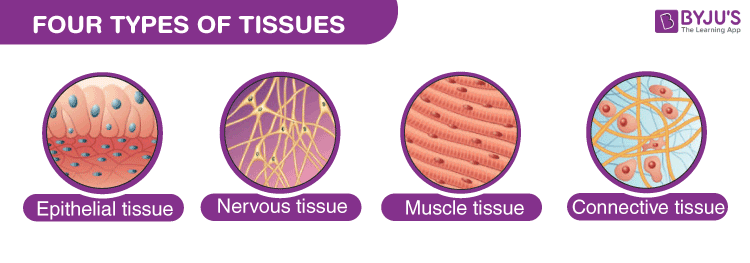Every cell in our body is specialised to perform a certain function. Similar kinds of cells constitute a tissue, which is classified based on the structure and functions performed by them. The human body has four main types of tissue; epithelial, connective, neural and muscular.
Download Complete Chapter Notes of Structural Organisation in Animals
Download Now
Table of Contents:

What Is Epithelial Tissue?
Epithelial tissue or epithelium forms the outer covering of the skin and also lines the body cavity. It forms the lining of respiratory, digestive, reproductive and excretory tracts. They perform various functions such as absorption, protection, sensation and secretion.
Structure of Epithelial Tissue
Epithelial tissue is formed from a tightly fitted continuous layer of cells. One surface of the epithelial tissue is exposed to either the external environment or the body fluid. The other surface is attached to tissue by a membrane, which consists of fibres and polysaccharides secreted by epithelial cells.
There is little intercellular material present between cells. There are specialised junctions present between the cells of the epithelium that link individual cells.
Tight junctions- prevent leakage across tissues
Adhering junctions- keep the neighbouring tissues well cemented together
Gap junctions- facilitate the movement of ions and molecules across the tissue
Epithelial cells form membranes. The epithelial membrane consists of a layer of epithelial tissue and has underlying connective tissue. There are two types of epithelial membranes, mucous membrane and serous membrane.
Mucous membrane: It is also known as mucosa. There are goblet cells present, which secrete mucus. The mucus helps in lubrication, protection and easy movement of materials. It prevents tissues from drying. It lines the body cavities such as respiratory and digestive tracts, which open outside the body.
Serous membrane: The serous membrane lines the body cavities, which do not open outside the body, such as the lining of the pleural cavity, pericardial membranes. These membranes secrete the fluid inside the cavity and are made up of simple squamous epithelium.
Glands are made up of epithelial cells. There are two types of glands, exocrine and endocrine. Exocrine glands secrete their product into a duct, e.g. goblet cells, sweat glands. Endocrine glands are called ductless glands and they release their product directly into the blood or intestinal fluid, e.g. hormones.
Recommended Video:

Epithelial Tissue Functions
Protection: As it covers the entire body surface, it is the first line of defence against any kind of mechanical injury, chemical exposure, excessive fluid loss and infections. Ciliary projections present in the nose or upper respiratory tract, trap the dust particles and prevent it from entering the body
Absorption: The epithelial lining of the digestive tract absorbs water and nutrients
Exchange of substances: Epithelial tissue regulates the exchange of substances between body and external environment as well as the internal exchange between different parts of the body. Everything that enters the body or enters the bloodstream by absorption has to cross the epithelial barrier
Sensation: Sensory receptors are present in the epithelial tissue of the nose, eyes and ears, taste bud, etc. that help in transmitting signals from the external stimuli to the brain
Secretion: Various glands made up of epithelial cells secrete hormones, enzymes, saliva, mucus, sweat, etc.
Types of Epithelial Tissue
There are three types of epithelial cells, which differ in their shape and function.
Squamous Epithelium – They are thin and flat cells
Cuboidal Epithelium – They are short cylindrical cells, which appear hexagonal in cross-section
Columnar Epithelium – They are long or column-like cylindrical cells, which have nucleus present at the base.
Also check:
On the basis of the number of layers present, epithelial tissue is divided into the simple epithelium and stratified or compound epithelium
Simple Epithelium- it is composed of one layer of a cell and mostly has a secretory or an absorptive function
Compound (Stratified) Epithelium- it is made up of two or more than two layers of cells and mostly has a protective function.
The glandular epithelium is made up of cuboidal or columnar cells. They are specialised for secretion.
Unicellular- isolated glandular cells, e.g. goblet cells
Multicellular- a cluster of cells, e.g. salivary glands
The columnar or cuboidal epithelium may bear cilia and are referred to as ciliated epithelium. They help in the movement of mucus in a specified direction, e.g. fallopian tubes and bronchioles.
| Types of Epithelial Tissue | Location | Structure | Function |
| Simple squamous | Blood vessel lining, air sac lining of lungs | A single layer of flat cells having irregular boundaries | Transport by diffusion and where minimal protection is required |
| Simple Cuboidal Epithelium | The tubular lining of kidneys, glandular ducts | A single layer of short cylindrical cells. It may have microvilli as in proximal convoluted tubules | Absorption and secretion |
| Simple Columnar Epithelium | Digestive tract and upper respiratory tract lining | A single layer of columnar cells (tall and slender) and often ciliated | Protection, absorption, mucus secretion and movement in a specific direction |
| Stratified Squamous Epithelium | The lining of the mouth and vagina | Made up of several layers of cells, continuously sloughed off and regenerated. The older layer of cells is pushed upwards and becomes flat. The lower layer is columnar and metabolically active | Protection |
| Stratified Cuboidal | Mammary glands, sweat gland and salivary glands | The upper layer is cuboid and other layers may be cuboidal or other types | Protection of ducts of various glands |
| Stratified Columnar | Male urethra and lobar ducts of salivary glands | There is a layer of columnar cells present on squamous, columnar or cuboidal epithelial cells | Protection and secretion |
| Pseudostratified Columnar | Respiratory passage and ducts of many glands | Similar to columnar epithelium but all the cells are not of similar height | Protection, secretion and movement of mucous |
| Transitional epithelia or urothelium | Urinary bladder, urethra, ureter | Stratified epithelium, which can contract or expand as per the requirement. Cells are cuboidal when not stretched, but when the organ stretches, then tissue gets compressed and cells appear irregular and squamous-shaped | Stretch readily to accommodate the different volume of liquids
Act as a barrier and have tight junctions to prevent reabsorption of toxic substances |
| Keratinised | The outer or apical layer of the cell | Mostly dead and devoid of nucleus and cytoplasm. The cytoplasm gets replaced by keratin, which makes the layer waterproof | Protection against abrasion |
Frequently Asked Questions on Epithelial Tissue
What Is The Function Of Epithelial Tissue?
Epithelial tissues are involved in multiple functions such as – absorption, secretion, protection, transportation, receptor function etc. rapid regeneration of these cells are critical in them being protective.
How Many Types Of Epithelial Tissue?
There are 8 types of epithelial tissues.
Simple squamous, Stratified Squamous, Simple Cuboidal, Stratified Cuboidal, Simple Columnar, Stratified Columnar, Pseudostratified Columnar and Transitional epithelia or urothelium.
Where Is Epithelial Tissue Found?
These tissues are widespread across the body. From blood vessel lining, air sac lining of lungs, digestive tract and upper respiratory tract lining, the tubular lining of kidneys, glandular ducts, the lining of the mouth and vagina, the lining of the male urethra and lobar ducts of salivary glands, mammary glands, sweat gland and salivary glands lining, urinary bladder, urethra, ureter lining, lining of respiratory passage and ducts of many glands, to the lining of an outer or apical layer of the cell, these tissues are found almost everywhere.
What Are The General Characteristics Of Epithelial Tissue?
All different types of epithelial tissues must have these characteristics – attachment, regeneration, polarity, cellularity and vascularity.
What Cells Are In Epithelial Tissue?
Based on the shape of cells, epithelial tissues have three types of cells: they are squamous, cuboidal, and columnar.
How Does Connective Tissue Differ From Epithelial Tissue?
The main difference between epithelial and connective tissue is in cells, that they are made up of and their functions. Epithelial tissue consists of three types of cells – squamous, cuboidal and columnar. Cells in connective tissue are immersed in an indefinite matrix in addition to cartilaginous, collagen, elastic or fatty tissues. The most common cell is fibroblasts, some others are macrophages, mast cells, adipocytes, plasma cells, leukocytes etc. Epithelial tissue lines body cavities, blood vessels, digestive tract, and other delicate internal organs, helping in excretion, transportation, absorption, protection and secretion. Connective tissue, on the other hand, connects, supports and binds to other tissues.
Also Check:
NEET Flashcards: Structural Organisation In Animals

Comments